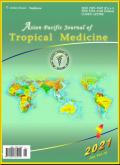Mycobacterium tuberculosis infection among children under fifteen years of age: A population-based study in Indonesia
IF 1.6
4区 医学
Q3 PUBLIC, ENVIRONMENTAL & OCCUPATIONAL HEALTH
引用次数: 0
Abstract
Objective: To assess the prevalence of Mycobacterium (M.) tuberculosis infection and its associated risks in children under fifteen years of age. Methods: Based on secondary data from the 2018 Indonesian Basic Health Survey (RISKESDAS 2018), this cross-sectional study employed M. tuberculosis infection in children as a dependent variable and age level, sex, region, location, family case positive, and smoking as independent variables. Geospatial analysis was applied to show the prevalence of M. tuberculosis infection and multivariate regression was performed to analyze the risk factors of getting the infection among children under 15 years of age. Results: Prevalence ranges of M. tuberculosis infection among children aged 0-14 years, babies (age <12 months), toddlers (age 12-59 months), and children aged between 5 and 14 years were 0.03% to 0.57%, 0% to 0.64%, 0% to 0.78%, and 0.01% to 0.53%, respectively in Indonesia. A high prevalence of M. tuberculosis infection among children under 15 years of age was found in Papua and other provinces, such as Kalimantan and Java. Contacting with tuberculosis family members was positively associated with M. tuberculosis infection in children as shown by multivariate logistic regression (OR 8.94; 95% CI 5.4-14.6, P<0.05). Conclusions: Contacting with family member who has tuberculosis is related with M. tuberculosis infection among children in Indonesia. Therefore, screening the household for contact with tuberculosis patients is a preventive treatment for children.十五岁以下儿童的结核分枝杆菌感染情况:印度尼西亚的一项人口研究
目的评估 15 岁以下儿童结核分枝杆菌感染率及其相关风险。方法:基于 2018 年印度尼西亚基本健康调查(RISAS)的二手数据:基于 2018 年印度尼西亚基本健康调查(RISKESDAS 2018)的二手数据,本横断面研究采用儿童结核分枝杆菌感染作为因变量,年龄水平、性别、地区、地点、家庭病例阳性和吸烟作为自变量。应用地理空间分析显示结核杆菌感染率,并进行多元回归分析 15 岁以下儿童感染结核杆菌的风险因素。结果印度尼西亚0-14岁儿童、婴儿(年龄小于12个月)、幼儿(年龄12-59个月)和5-14岁儿童的结核杆菌感染率范围分别为0.03%-0.57%、0%-0.64%、0%-0.78%和0.01%-0.53%。巴布亚以及加里曼丹和爪哇等其他省份发现,15 岁以下儿童的结核杆菌感染率较高。多变量逻辑回归(OR 8.94; 95% CI 5.4-14.6,P<0.05)显示,与结核病家庭成员接触与儿童感染结核杆菌呈正相关。结论与患有结核病的家庭成员接触与印度尼西亚儿童感染结核杆菌有关。因此,筛查与肺结核患者接触过的家庭是对儿童的一种预防性治疗。
本文章由计算机程序翻译,如有差异,请以英文原文为准。
求助全文
约1分钟内获得全文
求助全文
来源期刊

Asian Pacific journal of tropical medicine
PUBLIC, ENVIRONMENTAL & OCCUPATIONAL HEALTH-TROPICAL MEDICINE
CiteScore
4.00
自引率
9.70%
发文量
1936
审稿时长
3-8 weeks
期刊介绍:
Asian Pacific Journal of Tropical Medicine (ISSN 1995-7645 CODEN: APJTB6), a publication of Editorial office of Hainan Medical University,is a peer-reviewed print + online Monthly journal. The journal''s full text is available online at http://www.apjtm.org/. The journal allows free access (Open Access) to its contents and permits authors to self-archive final accepted version of the articles on any OAI-compliant institutional / subject-based repository.
APJTM aims to provide an academic communicating platform for international physicians, medical scientists, allied health scientists and public health workers, especially those of the Asia-Pacific region and worldwide on tropical medicine, infectious diseases and public health, and to meet the growing challenges of understanding, preventing and controlling the dramatic global emergence and re-emergence of infectious diseases in the Asia-Pacific.
The journal is proud to have an international and diverse editorial board that will assist and facilitate the publication of articles that reflect a global view on tropical medicine, infectious diseases and public health, as well as emphasizing our focus on supporting the needs of public health practitioners. The APJTM will allow us to seek opportunities to work with others who share our aim, and to enhance our work through partnership, and to uphold the standards of our profession and contribute to its advancement.
 求助内容:
求助内容: 应助结果提醒方式:
应助结果提醒方式:


